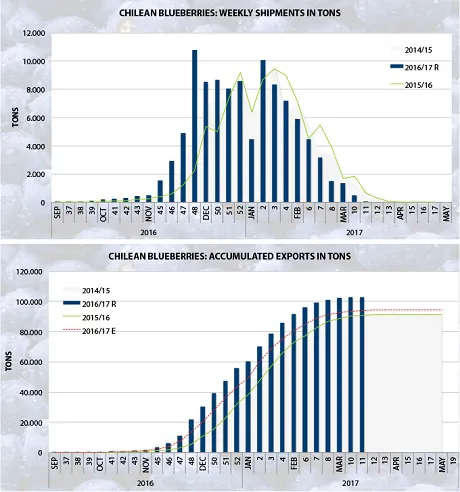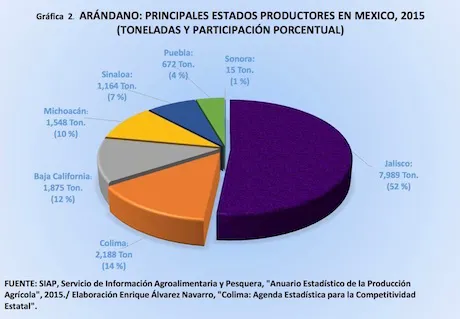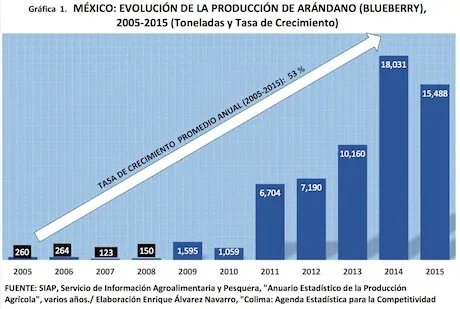The season is finished, although there are still some volumes to be exported, they will not substantially change the total volumes of the 2016-2017 season, which marked a new record in the Chilean blueberry exports, surpassing all forecasts and surpassing the 100,000 tons exported for the first time. Total exports up to week 11 are around 103,000 tons, 13% more than the total exported in 2015/16 and 9% more than was forecasted for this campaign. This historical record led to higher volumes shipped to Asian and European markets, which increased in 54% and 14% respectively, while North America grew 7%. As a summary, 63% of the volumes of this campaign were destined to the U.S, 22% to Europe and 12% to the Far East.

Another milestone of the season was the greater heat accumulation observed until week 50. As a result, the peak weeks, which historically occur around week 50, began two weeks earlier week 48. Consequently, the total exports up to the end of week 50 exceeded by 23,600 tons, the shipments of last campaign during the same period, that is +152%.
The highest volumes achieved in 2016-17 are based on 2 factors. Firstly the high stocks of frozen blueberries in the USA and secondly clearer markets in the late stage of the season. In this way, a scenario of better market condition was observed in the late part of the season. Thus, Chile's late harvests were focused on fresh exports so the volume decrease in the final stage was lower than projected.
The opening of new markets is high on the agenda of Argentina. The hope is that China will open up for export this year. National production is constantly evolving and they expect to have a great 2017 season.
According to the US Department of Commerce, Peruvian blueberry exports have increased by 494.5% during the last five years, and Peru has begun displacing the other exporting countries, which once dominated that market. This is at the cost of other Latin American countries. And Canada has been the supplier most affected by Peru's increased participation.
According to the latest figures from Mexico, during the period from 2005 to 2015, blueberry production reached an average annual growth rate of 53% from 260 tonnes in 2005 to 15,488 tonnes in 2015. The main blueberry producing states in Mexico, by volume of production, are Jalisco with 7,989t, (52%); Colima with 2,188t (14%) and Baja California with 1,875t (12%), entities that together represent (78%) of the 15,488t, that occurred in 2015. In Colima, blueberry acreage has increased at an average annual growth rate of 11.3% over the period 2012-2015 from 222 to 306 hectares; The production has also had a similar behavior to increase at a rate of 18.5% in the same period from 1,318 to 2,188 tons. The biggest share is for US and Canada.


The American market is just coming out of the shortest supply window of the year. Chile has ended and domestic production is starting up. Florida’s harvest started last month and is peaking right now. The sunshine state had a mild winter that resulted in good growing conditions for the crop. Georgia and North Carolina, two important blueberry states, have had devastating crop losses due to frost. Production in Georgia, one of the largest blueberry states, is expected to be down about 60-70 percent due to the frost that hit in March. Georgia’s season typically starts April 15 and runs through July 1st. North Carolina is estimated to have 50-70 percent loss from the frost. The state’s blueberry harvest starts mid-May and also runs through July 1st. According to Lockman, the frost will cause a gap in production between May 15 and June 10.
Blueberries are steadily becoming a more popular fruit in China. Four or five years ago, when blueberries started to draw people’s attention, they were sold at more than 150 Yuan (20 euro) per 500 gram. As a result, farmers were eager to start cultivating blueberries. Blueberry production in Shandong Province, where most of the production takes place, has increased by at least 50% compared to four years ago. Domestic blueberries will be available on the market around the 25th of April and the supply will last till the end of July. A few years ago, many farmers and plantations extended their blueberry growing area, driven by the high profits involved. That resulted in the steady fall of blueberry prices. This year, the total production area and volume are relatively stable, so the market prices are expected to be level with the prices from last year. China originally imports blueberries from Chile. Earlier this year the first shipments of Peruvian blueberries arrived on the market.
The demand for blueberries in Israel has been on the rise, and the supply and demand have been out of balance for several years as a consequence. Prices for locally grown blueberries are around 20 euros per kilo, and are reaching as much as 25% higher in times of short supply; even imported fresh blueberries are sold for no less than 15 euros per kilo and frozen blueberries up to 10 euros per kilo. The high prices however have not deterred Israeli consumers, as the blueberry sales have gone up year over year.
Israeli growers have made efforts to increase the local supply to meet the demand and generate a profitable new category in the local market, but difficulties with growing conditions have hampered this development. Currently most of the successful commercial blueberry farms are located in the northern part of the country in regions with cold weather conditions and limited exposure to heat during the growing season. Growers anticipate that the developments of new varieties, specially adapted to the local climate, will allow the market to grow in the coming years; this is expected to take effect only further in the future, meaning that the current market conditions and prices will remain at least for this coming season and the next.

The blueberry harvest has come at the normal time this year in Huelva, compared to last season when it was much earlier due to high temperatures. On the other hand, the transition in the market between the blueberries from the southern hemisphere and the Spanish blueberries has been very fluid. After two months with very homogeneous prices, they have begun to decline at the moment in which the volumes of production in Huelva are significantly increasing. A grower admits that although in Huelva they have grown in volumes of blueberry production, it is still a relatively new crop to which they have to adapt, both at the agronomic and commercial levels. In the sector there is some uncertainty about a possible oversupply of blueberries in the current and in the next campaigns. The blueberry acreage has increased a lot in Huelva and there are still large yields to come, so there are some doubts as to whether the market will be able to absorb such large amounts.
In Piedmont, 2016 was a very good year in terms of both production-quality and price. The surface dedicated to blueberries is increasing, 100 hectares more are expected. This year blooming was good; at the moment there aren't problems, so a good production and prices are expected. The harvest will begin in May. In order to be present throughout the country, from North to South, and especially to anticipate commercial production by extending the calendar, blueberry cultivation is carried out also in Calabria.
Blueberry sales are up at the moment, after supermarkets ran campaigns, selling them at low prices, says a trader. "The blueberry campaign has made things difficult, because, while the supermarkets are selling the berries for between €1.00 to €2.25 for a punnet (sometimes two) of 125grams, the importers are paying €22.50 for a 12x 125gr box. We are paying higher prices at the moment because of the gap in supplies while the Southern Hemisphere is winding down and we are waiting on the new supplies from Morocco and Spain."
European production is increasing, which is a sign that the market, France included, is growing. No major plantations have been set up recently so no huge growth expected in France this season. Production looks good this year and is not expected to reach more than 3,000 tons in France, which is stable compared to last year. About 75% of the French production is exported. The French market is well balanced for the moment in terms of supply and demand. Competition comes from imported blueberries, from Holland for example, where they are harvested mechanically and are cheaper than the than exported French blueberries. However, French blueberries have direct access to national retailers whilst it is difficult for foreign operators to access the French market, so for the time being the French products are protected from too much imported competition. The biggest threats for French blueberry production come from Portugal, Northern Spain, Romania and Bulgaria.
As in other countries, Belgian traders are seeing an increase in consumption. Retail is using this to market in different packaging from 125 gram to 500 gram. The most important suppliers of blueberries are: Spain, Morocco, Netherlands, Peru, South Africa and Chile.
It is difficult to estimate at this point as the weather is very unstable. Poland had significant winter frosts at the beginning of the year. After two weeks of exceptionally warm weather. Poland is expecting more cold snaps and we are affraid of the nightfrost. The main markets are the UK, Germany and Scandinavia. Some berries go to Asia, but at this point, only in limited volumes.
There have been investments in production in the Middle-East and demand is increasing. Between 2014 and 2015 the consumption grew in the Emirates by 7.6%. The season started at the end of the summer. Besides that companies are trying to ensure supplies by having production projects outside the region, in countries like Morocco and Serbia.
